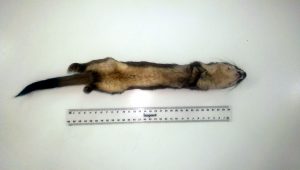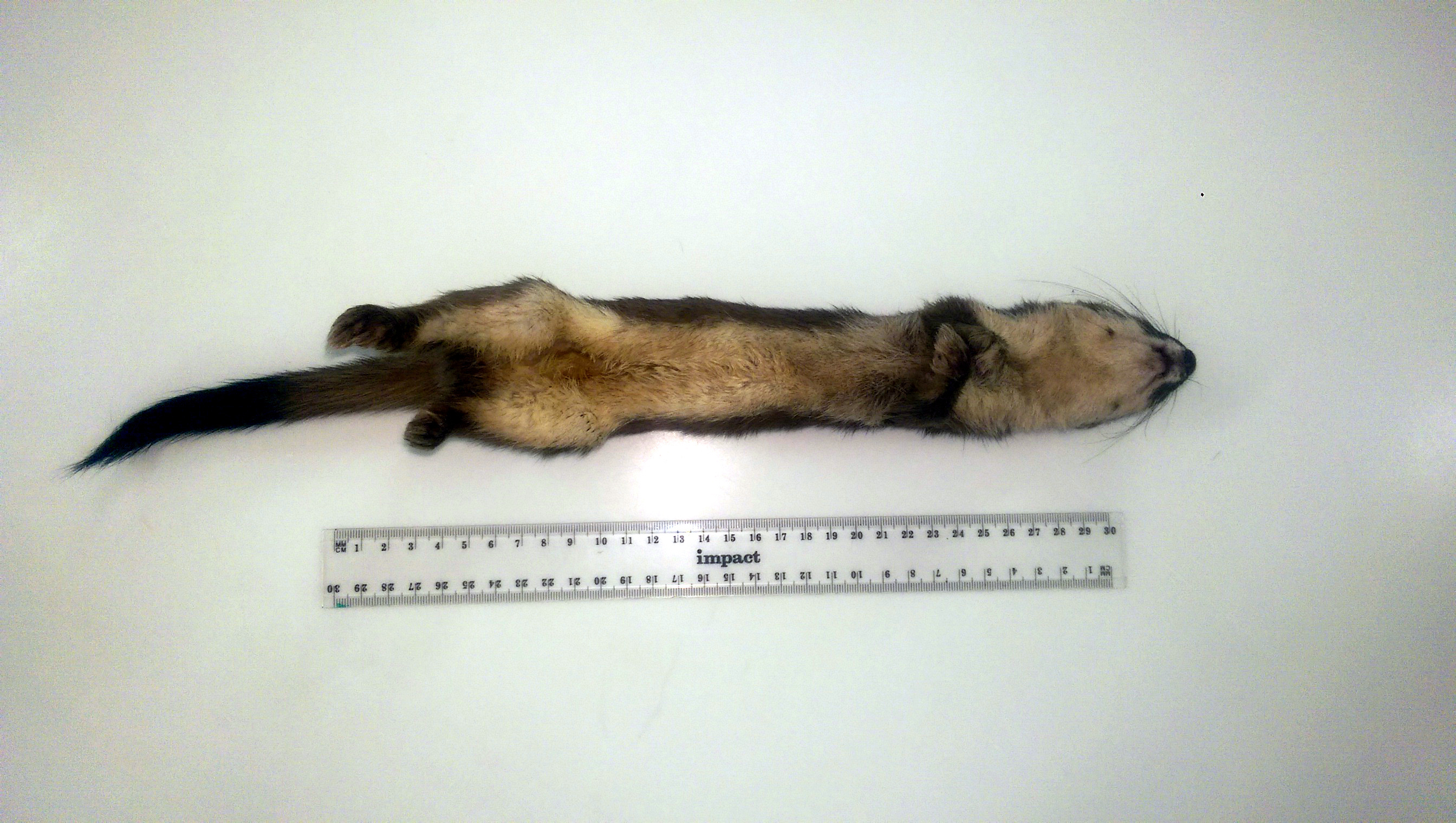An important first step has been taken towards assembling and annotating the genome of our most voracious introduced predator, with the capturing of “Stan” the stoat. Stan, a one-year old male stoat, was live trapped in a cage-trap in the Hikutaia Valley, south of Thames, as part of pest management activities.

Figure 1 Stan the stoat, shortly before dissection.
The stoat genome sequencing project, led by Unitec’s Dr Andrew Veale, will cost over $50,000, and is jointly funded by the Bioheritage Challenge – high-tech pest management solutions, and PredatorFree2050.
What makes Stan special?
There are multiple reasons Stan is the ideal animal for genome sequencing, and searching from him has taken over a year. So why is Stan special?
Firstly, Stan is a male.
In mammals, males have one X chromosome and one Y chromosome, while females have two X chromosomes. Therefore, if we want to sequence a Y chromosome, we need a male. If, however, we were sequencing a bird then we would need a female!
Secondly, Stan’s DNA is in perfect condition.
You can get DNA out of ratty old samples, even ancient bones, so why use a live trapped stoat for this project?
DNA starts degrading as soon as an animal dies. If you take DNA from an animal that died the previous day, the DNA will still be very good, in pieces probably tens of thousands of base pairs long, but it probably won’t be perfect. Over time, DNA breaks up more and more, so after a few weeks of decay it will be in millions of pieces, each only hundreds of base pairs long, and ancient samples are generally less than 100 base pairs.
So, to have perfect DNA in complete chromosomes millions of base pairs long, you need a DNA sample as fresh as possible before any decay begins.
Thirdly, there will be minimal contamination.
There is one other factor important to genome assembly, and that is how pure the sample is. All DNA looks the same, whether it is from a bacterium or a stoat, so contamination from anything else present in the sample will be sequenced at the same time. Teasing out these contaminated reads of DNA requires intense bioinformatic filtering on the computer. Bacteria will rapidly increase once an animal is dead. For a perfect stoat genome, we want to sequence stoat DNA, not bacteria, so again DNA from a fully fresh sample is needed.
Lastly, sequencing a genome requires a low genetic diversity individual.
Assembling a genome is a bit like a giant jigsaw puzzle, but one of the many technical problems along the way is that we all have two copies of this jigsaw puzzle mixed together. This is because we have two copies of each chromosome, one inherited from our father, and one from our mother. Individuals that are genetically diverse – with distantly related parents, effectively have two different genome sequences. When the computer tries to assemble these, it looks for overlapping similar sections of reads. If the two copies are different enough then the computer won’t match them, and it won’t merge them – breaking the DNA sequence. Do that enough times and instead of having 23 pairs of chromosomes (for a human) or 22 pairs for stoats, we would have hundreds of thousands of bits. Ideally, therefore we want inbred individuals with low genetic diversity to make it easier for the computer.
While thousands of stoats were introduced to New Zealand, most came to the rabbit filled inland parts of the South Island. The recorded releases in the North Island occurred near Wellington, and then they spread up the country over the next 20 years. This means northern New Zealand has lower genetic diversity, and Stan will have a comparatively easy genome to sequence.
What is the process to sequence a genome?
He was taken to a veterinary clinic in a closed dark box with bedding, and humanely euthanized after being sedated. An ending as comfortable as possible as while he is a pest, he was also an intelligent creature deserving our respect – something too often forgotten by New Zealanders. His body was then immediately taken to the Applied Molecular Solutions lab at Unitec for dissection. All organs were removed using sterile techniques like a doctor’s surgery, and immediately frozen to -80°c. That will keep all of the DNA in perfect condition.
Samples of liver and spleen will now be sent to the Vertebrate Genome Laboratory at the Rockerfeller institute in the USA.
Multiple complex sequencing technologies will now be used to sequence the genome in different ways. The sequences generated by these different technologies will then be combined on super-computers throughout north America and Europe to create a complete, annotated genome. If you’re interested in DNA sequencing, and why we need to use so many different techniques, here are some videos detailing the various technologies:
PhD research, Dr Veale evaluated population connectivity of stoats using genetic markers called microsatellites. On Secretary Island, he showed that stoats were both surviving the intense trapping network (1000 traps over an island about the size of Waiheke), and that they were swimming across from the mainland. These genetic markers are not very sensitive however, and working out the precise relationships between individuals requires a genome to provide thousands of markers linked to a map.
With a sequenced genome we will also have the sequences for all of the genes relating to olfaction (smell). Perhaps we can find in these sequences ways to make the perfect lure to attract them? We will have the genes for immune function, therefore we may also be able to find things that they are sensitive to that could help us control them. There are also possible genomic techniques to control invasive species, such as gene drives. These technologies are largely hypothetical in mammals, and will require huge amounts of technical research, along with consultation with all the people of New Zealand.
In truth, we don’t know everything that a sequenced stoat genome will give us. Undoubtedly there are many further unimagined uses for this information to help us understand and control stoats. This will then help us save our precious taonga species, like kaka, weka, mohua and tieke, which is the whole point of pest management in New Zealand.

“Will all great Neptune’s ocean wash this blood clean from my hand? No, this my hand will rather the multitudinous seas incarnadine, making the green one red.”
Contact
Dr Andrew Veale
aveale@unitec.ac.nz
